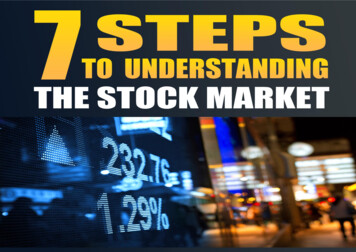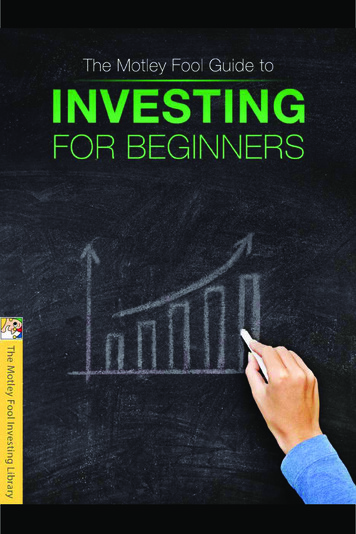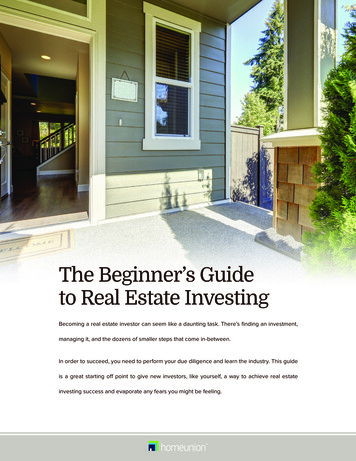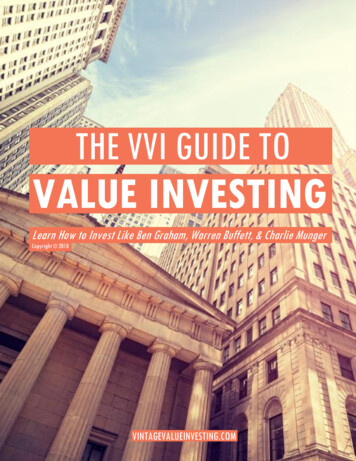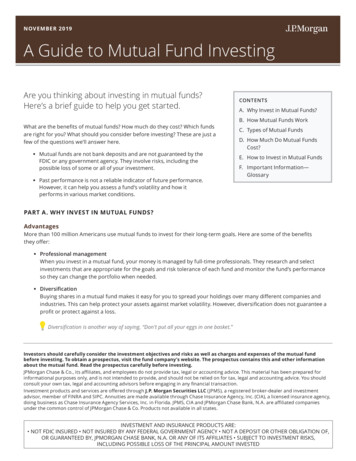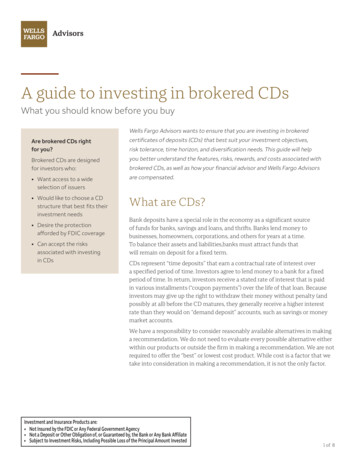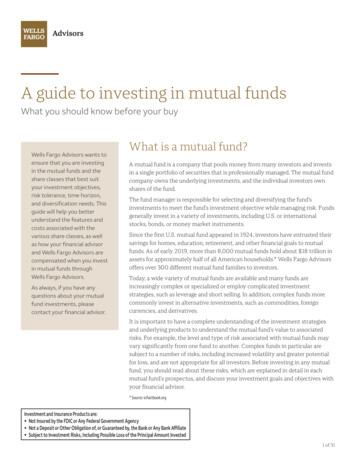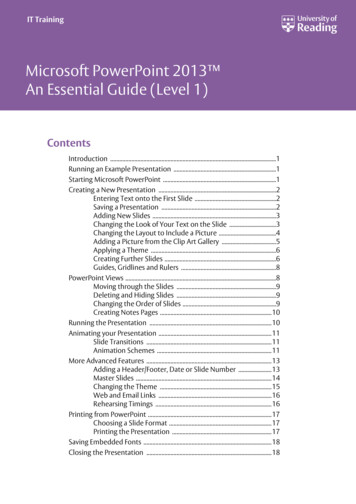
Transcription
A Beginners Guide to Investing in the Share MarketIntroductionTo many people, investing seems too complicated, too difficult, or just too risky.They are confused by the massive amount of information available, the many different types ofinvestments and the countless opinions presented by so called market experts.In producing this CD, our primary objective is to provide individual investors with sufficientinformation to enable them to make informed investment decisions.This CD, together with the accompanying training modules, are designed to introduce you to thestock market and outline some investment strategies that will enable you to consider whether ornot to invest some of your money in shares. You will learn essential concepts of investing such asthe characteristics of top performing stocks and how to identify those stocks, and the correcttime to buy and sell stocks to maximise gains and minimise losses.There are many different ways for you to invest your money. Some are more risky than others.Some involve having your money tied up for a long time, others promise quick short-term gain.Not everyone will wish to invest his or her money in the same way.However, investing in shares is one of the more stable forms of investment available, whetheryou are after a short, medium or long-term investment.After viewing this CD and the accompanying training modules you will have a good idea of howthe share market works and how to invest in shares that suit your particular needs. Whether youact on this information is, of course, entirely up to you.Four Simple Rules to Financial IndependenceLet’s assume that you are completing this training program because you want to increase yourwealth and you want to achieve financial independence through investing in the share market.It’s true that many investors have become wealthy by investing wisely in the share market, but itis necessary for you understand some basic investment principals before investing in shares.Don’t be fooled by the simplicity of the statement that there are four simple rules that if followedwill lead you to financial independence, because if you follow these rules you will be well on theway to financial independence.1. Spend less than you earnThis maxim may seem obvious but many people have difficulty following it. If you’re spendingmore than you earn, you will never be able to become financially independent. You will be payingmoney to others for the rest of your life. The earlier you start living by this rule, the better, but itis never too late.2. Save 10% of your income and invest it wiselyIt may surprise you but the average Australian, earning between 30,000 and 50,000 a year for40 years, will earn somewhere between 1,200,000 and 2,000,000 during their working life. Yetmost of them will retire poor.Saving just 10% of this along the way would provide a nest egg of 120,000 to 200,000 thatcould be used as the basis for an investment program. So the level of your income has no
bearing on the level of wealth you achieve, what is critical is the amount you save.Many studies have shown that a sensible and knowledgeable private investor can expect theirinvestment portfolio to out perform those of many professional fund managers. That is becausethe individual investor has flexibility, agility and low overheads.3. Develop an investment plan and allow your investments to grow‘If you fail to plan . you plan to fail’.If you want to achieve your investment goals, whatever they are, it is critical to develop aninvestment plan. Then you must adhere to the plan and only change when there are significantchanges in the basic factors. Ideally, leave your investment alone and let the magic ofcompounding do its work.But start now!On average, people need about 75 percent of their pre-retirement income to maintain theirstandard of living throughout their retirement. That translates into consistently saving about 10percent of your income throughout your working years.The longer you wait though, the harder it gets. Every decade you put off saving nearly doublesthe amount you have to save to meet your retirement goals. For example, if you need to save 5percent a year starting in your early 20s to attain retirement bliss, you'll need to scrimp and save10 percent annually if you wait until your 30’s to start saving. And if you wait until your 40, theamount jumps again to 20 percent.4. Understand the Power Of CompoundingThe principle of compounding suggests that even a small sum of money can grow into a hugeinvestment over time. It has been said that when Albert Einstein was asked "What is the mostpowerful force in the universe?" he replied "the power of compounding!"What this means to you is that if you invest, even a small amount, in an asset that grows invalue over time, and you reinvest the income from your investment (the interest you receive, orthe rent you receive from your property investment, or the dividend you receive from yourshares), the magic of compounding will work miracles for you.It also means that you can no longer use the argument " I can only save 5 a week, so it’s nouse. It will never amount to much." Even small regular savings compound to large sums over theyears.Why Invest in Shares?Although there are many options available in which to invest your money, few of them offer thesame security and likelihood of consistent profits than the share market. However, otherinvestment options do offer some advantages over shares.Fixed interest offers security. Cash offers liquidity. Property investors can directly increase thevalue of their investment by renovating, extending or even knocking down the property andrebuilding. It is also easier to borrow money against a property than it is against shares. Overallthough, there are many reasons for shares to be considered above other options.Ten-year investment tableFirst, and most importantly, over medium to long-term periods, shares invariably return higheroverall returns than most other forms of investment. The table shows shares outperforming the
other types of investments over a ten-year period.Report compiled by Towers Perrin for the Australian Stock Exchange in September, 2001This result is not confined to this particular period. Throughout this century, shares havereturned greater profits, more consistently, than the other forms of investment. These returnscan be delivered in one of four ways: the initial dividend yield, increasing dividends, tax benefitsand increased share value.Initial dividend yieldsThe initial dividend yield is the share of its profits that a company pays to itsshareholders. The dividend is generally paid every six months. Not all of the company’sprofits are paid in dividends. A company’s board of directors will usually decide howmuch of the profit should be distributed back to the shareholders and how much shouldbe ploughed back into the business to increase further the company’s worth. In somecases, the board may decide to re-invest the entire profit.Increasing dividendsIncreasing dividends are paid out by well-performing companies that experience anannual increase in profits over a number of years. They are in a position to be able toincrease their dividend payout so that it consistently keeps pace with or outstripsinflation.Tax benefitsTax benefits from shareholdings are available because many companies pay tax on theirprofits, meaning investors receive tax credits on the dividends they receive. Often,shareholders pay little or no tax on the dividends they receive.Increased share valueIncreased share value occurs as the value of individual shares increases, resulting in anoverall increase in an investor’s portfolio. However, the increased share value only has apaper worth unless the shareholder decides to sell some or all of the stock.
Shares are a liquid investmentApart from their consistent performance, there are other reasons why shares are an attractiveinvestment option. They are a liquid investment. That is, they can be bought and sold asrequired. Selling a property can take months. Selling a share can take seconds. Shareholders canchoose to divest themselves of just a portion of their holdings in a particular company, or theycan sell the lot. Such an option is not available with property.It is easy to ascertain the true value of sharesAnother advantage is that the true value of a share investment can easily be ascertained. It is assimple as looking up the daily share market results in the newspaper or on your computer. Ifonly it was that easy to value a property.DiversificationCreating a share portfolio enables you to invest in a number of industry sectors. By investing incompanies operating in different industry sectors, you minimise losses from one badly performingsector. As one sector suffers a downturn, another may be experiencing growth. This is one of themajor reasons that a well-balanced share portfolio invariably outperforms many other types ofinvestments.What is the Stock Market?The Australian Stock ExchangeSo what is the stock market and what are shares?The stock market is where the buying and selling of company shares takes place. In Australia,these transactions take place through the Australian Stock Exchange, or ASX as it is known. Itwas formed in 1987 by amalgamating the six capital city stock exchanges. The amalgamationwas necessary because of financial deregulation and the accompanying increase in internationaltransactions.Before 1987, most of the action took place on the floor of the stock exchanges. Transactionswere shouted, prices were chalked up on a board, in fact, to most of us, it seemed as if therewas little order to the goings-on. However, the ASX introduced the Stock Exchange AutomatedTrading System (SEATS), which by 1990 had taken over all transactions. SEATS allows trading tobe conducted through a computer system. Transactions are processed in the order in which theyare made and the system links buyers and sellers. It may not match the drama of the past but itis far more efficient.S&P/ASX 200 Composite IndexThe state of the stock market is judged by the S&P/ASX 200 Composite Index, which recentlyreplaced the All Ordinaries Index, formerly known as the All Ords.The S&P/ASX 200 Composite Index is a measure of 200 of the largest and most frequentlytraded stocks on the Australian share market. Measuring their rise and fall allows us to have afairly accurate reading of how the Australian market as a whole is faring.The American equivalent of the S&P/ASX 200 Composite Index is the Dow Jones Index. Eachmajor share market around the world has its own index to help investors rate how the market isfaring, plus a number of sub indices such as the industrial index, a gold index or a resourcesindex, that measure particular sectors.
What are Shares?When you buy shares in a company, you are buying a share of the ownership in the underlyingcompany, complete with the right to a share in the firm's future earnings. The more shares youbuy, the more of the company you own.So why does a company issue shares? Well, usually a company will issue shares when it needs toraise capital (money) for expansion, research and development, for its general operations or topay off debt. The company could also use other options such as getting a loan from a bank orissuing bonds or debentures. One of the advantages of issuing shares is that shares raise capitalwithout debt and without a legal obligation to repay the funds, unlike bank loans or bonds, whichare direct debt obligations of the issuing corporation.The first time a company sells stock to the public it is known as a Public Float or Offering, orsometimes referred to as 'going public'. There are thousands of publicly listed companies you canpurchase shares in, from a diverse range of sectors.There are also different types of shares.1. Ordinary sharesThe most common type of shares are known as ordinary shares. Purchasing ordinaryshares gives the owner a stake in the company and an entitlement to dividends.Dividends are the part of the company's profits that are paid out to the shareholdersevery six months when the company is making a profit. Most ordinary shares also givethe shareholder a right to attend the company’s annual general meeting and vote onissues relevant to the company’s future.2. Preference sharesPreference shares return a fixed dividend to the investor that is not linked to thecompany's annual profit result. Although preference shareholders receive dividendsbefore ordinary shareholders, they do not receive the same voting rights as ordinaryshareholders.3. Contributing sharesContributing shares are those that have not been fully paid for and require furtherpayment in the future. Dividends are generally paid according to the proportion of thepaid-up amount.4. Bonus issuesA bonus issue is a free issue of new shares to existing shareholders. Every now and thenwhen a company makes an extraordinary profit, or if it has amassed accumulated profitsover a period of time, it gives its shareholders a present of a bonus issue of shares at nocost. Receiving a bonus issue does not increase the proportion of a company owned bythe shareholder, as all shareholders receive the same present in proportion to theirownership of the company. It is, in effect, a cashless dividend.5. Rights IssuesA rights issue is also an issue of new shares to existing shareholders. However, these arenot free. A rights issue occurs when a company needs to raise extra capital and it givesits shareholders a right, but not an obligation to purchase extra shares. There are twotypes of rights issues, renounceable and non-renounceable rights. Renounceable rightscan be traded on the share market if an existing shareholder does not wish to purchasethe new shares being offered to them. They are therefore of some value to theshareholder - a little bonus. Non-renounceable rights cannot be traded or sold to others,so if the shareholder does not take up their right to buy t
A Beginners Guide to Investing in the Share Market Introduction To many people, investing seems too complicated, too difficult, or just too risky. They are confused by the massive amount of information available, the many different types of investments and the countless opinions presented by so called market experts. In producing this CD, our primary objective is to provide individual .
